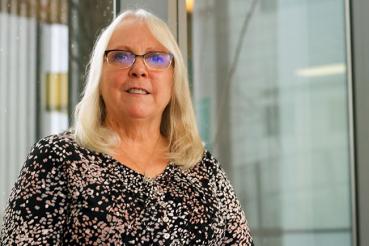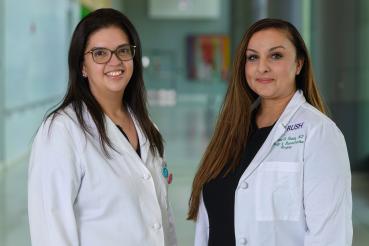The Rush Approach to Breast Reconstruction Surgery
If you’re thinking about having breast reconstruction surgery, it's normal to feel concerned — especially if you’ve had or will have breast cancer treatment, too. You may have questions about your procedure, what your breasts will look like and whether you may have sensation after.
Our breast reconstruction surgeons and providers in Chicago and the surrounding area understand your concerns and the need for sensitivity and compassion. They’ll listen to you and answer your questions respectfully, giving you the power to make informed decisions about your treatment.
Rush is a high-volume center, which means our surgeons help many patients get the results they need every year. And their high level of training and experience with a variety of cases lets them offer you the full range of breast reconstruction options and surgical procedures.
They know that every patient is unique. They’ll make sure you feel understood, confident and in control of your care. Putting your needs first, they’ll create a plan that is right for you and meets your goals.
What Is Breast Reconstruction Surgery?
Breast reconstruction is a surgical procedure that restores your breast after you've had a mastectomy or lumpectomy to treat breast cancer.
It can also help if you're unhappy with the results of previous breast reconstruction surgery. For example, if you had implant-based reconstruction, an infection might make it so that your implants need to be removed, or your implants can shift. If you had autologous flap reconstruction, you might not be pleased with your breast shape or symmetry.
Corrective surgery can happen soon after your reconstruction surgery, or much later.
If you’re experiencing any of the following issues or aren’t happy with the look of your breasts after reconstruction surgery, our team can help you return to looking and feeling your best:
- A lump or area of excessive firmness
- Breast asymmetry
- Breast pain or discomfort
- Changes in breast size, shape or position
- Feeling of chest tightness
- Shift in the position of the implant, or an implant that was never positioned correctly
The expert breast reconstruction surgery team at Rush works closely with you to understand your goals for size, shape and appearance, and to ensure that your surgery gives you the breasts you want.
Breast Reconstruction Procedures Available at Rush
Breast reconstruction starts with a conversation with your breast and reconstructive surgeons about your goals for your appearance and the kind of surgery that makes sense for you.
Reconstruction options available at Rush include the following:
- Autologous breast reconstruction, which uses a flap of your own tissue taken from another part of your body, most often the abdomen, to give you a soft, natural-looking breast. Your reconstructive surgeon will determine if you are a good candidate. The following are different types of flap procedures:
- Pedicled flap surgery: The tissue stays partly attached to the donor site and is moved to your chest with that blood supply intact.
- Free flap surgery: The tissue is completely removed and transplanted to your breast — a complex procedure that requires specialized microvascular surgery to attach the blood vessels in the tissue to the vessels in its new location. Rush is one of only a handful of Chicago-area health systems offering this surgery.
- TRAM flap breast reconstruction: This uses tissue from the transverse rectus abdominis muscle in your lower abdomen.
- DIEP flap breast reconstruction: This spares the muscle by using skin, fat and blood vessels, called “deep inferior epigastric perforators,” taken from the lower abdomen.
- Direct-to-implant reconstruction is a new option that can remove cancer and restore your breast in a single surgery. A saline or silicone implant is placed either in front or behind your pectoralis muscle immediately after your mastectomy is completed. Rush surgeons are the Chicago area's most experienced with direct-to-implant reconstruction.
- Tissue expander and implant reconstruction is the most commonly performed option in the country to reconstruct a breast. A tissue expander is part of a staged reconstruction that allows the surgeon to start the reconstructing process at the same time as the mastectomy. At Rush, we most commonly place the expander in the prepectoral position, or in front of the muscle. This may lead to quicker recovery, less pain and a more aesthetically pleasing final result. After your breast surgeon removes the cancer and surrounding tissue, your reconstructive surgeon will place a tissue expander to stretch the chest skin gradually. After a few months, your surgeon will remove the expander and replace it with a permanent implant. You may want to have your other breast enlarged, lifted or reduced during this second operation to achieve better symmetry.
- Combined tissue expander and implant reconstruction with latissimus flap may be the best path for you if you've had radiation or don't have enough breast skin to accommodate a tissue expander. A latissimus flap uses tissue from your back to replace scarred breast tissue and cover the implant.
- Reduction lumpectomy and oncoplastic breast reduction is a relatively new option if you're having breast conservation surgery — the removal of the breast cancer and some breast tissue, also known as a lumpectomy — and have large or sagging breasts. Your breast surgeon will remove the cancer and will work with your reconstructive surgeon to perform a breast reduction or lift during the same surgery.
Breast Reconstruction Timing
You might have reconstruction at the same time as your mastectomy, double mastectomy or lumpectomy, or you and your surgeon might choose to delay it. The timing of your reconstruction depends on several factors, including the following:
- The stage of your breast cancer
- Your overall health
- Your personal preference
- Your lifestyle
- Any other treatments you had for breast cancer, such as radiation
Most patients can have breast reconstruction at the same time as their mastectomies. This is called immediate reconstruction.
But reconstruction can also happen later — weeks or even years after a mastectomy. This is called delayed reconstruction. Your surgeons will help you decide when to have breast reconstruction surgery.
How Breast Reconstruction Revision Works
If you’re unhappy with a previous breast reconstruction surgery, your surgeon will talk to you about your situation and create a custom treatment plan.
Depending on the issues you’re having, your surgeon might recommend replacing your implants or reshaping the breast by taking fat from another part of your body via liposuction and injecting it into the breast.
A breast lift, breast augmentation or breast reduction surgery to adjust breast size could also be part of your plan.
Whatever the approach, your surgeon’s goal will be to create breasts that look and feel natural and symmetrical.
How Long Does it Take to Recover From Breast Reconstruction Revision?
Your recovery time will depend on the procedure(s) you have — and as with every surgery, recovery is highly individual.
During your consultation, your doctor will talk to you about what to expect.
Rush Excellence in Breast Reconstruction
- Leaders in surgical advances: Our surgeons are pioneers in implant-based and autologous breast reconstruction, with years of expertise in performing advanced techniques in implant-based and microsurgical tissue-flap procedures, including lymphatic procedures. They're the most experienced team in the Chicago area for prepectoral and direct-to-implant reconstruction with advanced training from the nation's top cancer training fellowships.
- Restoring breast sensation: Many women feel numbness in part or all of their chest after breast restoration. But our surgeons can perform advanced grafting procedures that help nerve fibers repair themselves. These resensation techniques may bring feeling back to your breasts after surgery.
- The beautiful, natural look you want: Breast reconstruction is equal parts art and science. Our surgeons who do these procedures are all board-certified and fellowship-trained in plastic and reconstructive surgery, and all are highly skilled at translating your goals into the results you envision.
- A care team that puts you at the center: Your reconstructive surgeon is part of your full breast cancer care team — including your breast surgeon and oncologists — who work together to create your custom treatment plan. Whether you're having surgery as part of breast cancer care or as a preventive measure, understanding your reconstruction options is an essential part of your treatment.
- Convenient care: Because our surgeons work from many locations in Chicago and the surrounding suburbs, you can schedule your pre-procedure appointments and post-procedure follow-up at an office that's convenient for you — and because they're all part of one integrated health system, your care is seamless.
Frequently Asked Questions About Breast Reconstruction Revision
You have many options, including replacing your older implants with new, state-of-the-art implants or removing the implants and having a reconstruction that uses a tissue flap from your own body, called autologous reconstruction. Your surgeon will talk with you about which approach would work best for your goals.
If your surgeon recommends another tissue-based reconstructive procedure, this time you may need to use a different donor site, such as your buttocks. It’s also possible to revise the original donor site if you have cosmetic concerns.
Nipple and areola reconstructions are options starting three to four months after your initial surgery. Your surgeon might use the surrounding skin or a skin graft from elsewhere on your body to form a new nipple; after the site has healed completely, you might choose to get a medical tattoo, also called micropigmentation, to add color that creates a new areola.
Breast reconstruction after lumpectomy is typically covered by insurance, but it may not be in every case for every procedure. You must check with your insurance provider about coverage for individual hospitals, physicians and procedures. They will be able to provide you with specific information about your plan and let you know what they will cover. You can also find answers to general insurance questions on our Insurance page.
Medicare may cover breast reconstruction in cases where it is deemed medically necessary. But you must discuss this with your surgeon. You can find more information on the official Medicare website.





